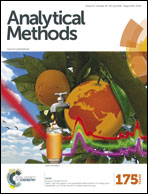An electrochemical sensor based on fullerene nanorods for the detection of paraben, an endocrine disruptor†
Abstract
In the present work, fullerene nanorods (C60NRs) were synthesized by liquid–liquid interface and characterized using Fourier transform infrared (FTIR) spectroscopy, field emission electron microscopy (FESEM) and X-ray diffraction (XRD) techniques. The C60NRs were covalently immobilized on the surface of a glassy carbon electrode (GCE) using surface bound diazonium salts as an interface. This method involves electrografting of the p-nitrophenyl diazonium salt at the GCE to give the nitrophenyl-modified electrode (GCE–Ph–NO2). The nitrophenyl groups of the GCE–Ph–NO2 modified electrode were reduced to phenylamine groups (GCE–Ph–NH2) using an aqueous solution of the sodium borohydride/gold–polyaniline (NaBH4/Au–PANI) system. The C60NRs were covalently immobilized on the surface of GCE–Ph–NH2via an N–H addition reaction across the π-bond of C60. The functionalized fullerene nanorod (C60NRs–NH–Ph–GCE) modified electrode was electrochemically reduced in 1.0 M potassium hydroxide (KOH) to produce a highly conductive electrochemically reduced fullerene nanorod (ERC60NRs–NH–Ph–GCE) sensor. The developed sensor shows high electrocatalytic activity for the detection of ethylparaben (EP) over a concentration range from 0.01–0.52 μM with a detection limit (LOD) of 3.8 nM (0.0038 μM). In addition, the ERC60NRs–NH–Ph–GCE sensor was also tested for EP in real sample analysis using the standard addition method where the total concentration of EP was found to be 0.011 μM (0.12%) within the permissible limit of 0.19%.


 Please wait while we load your content...
Please wait while we load your content...